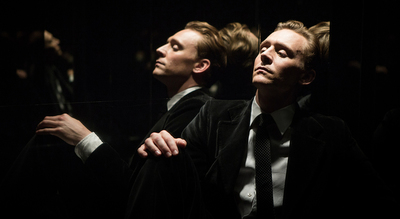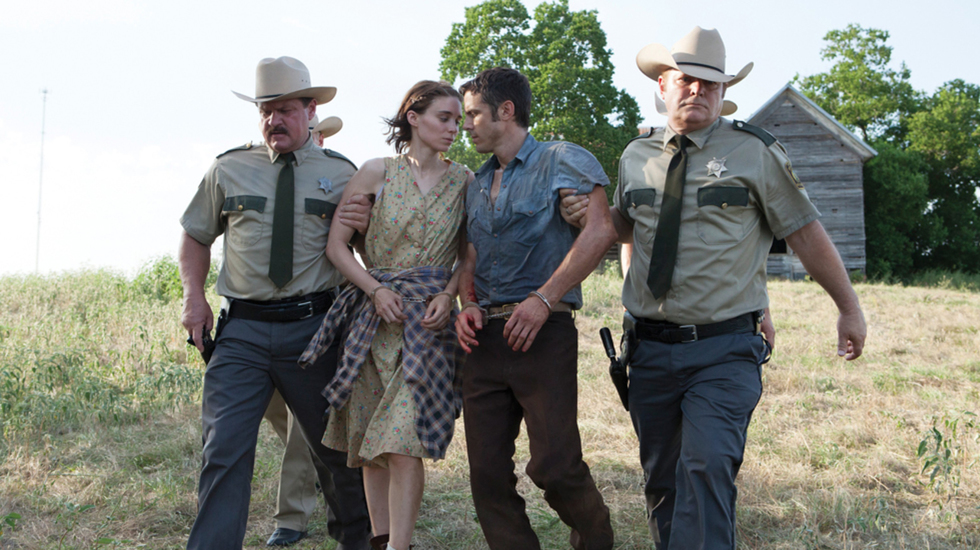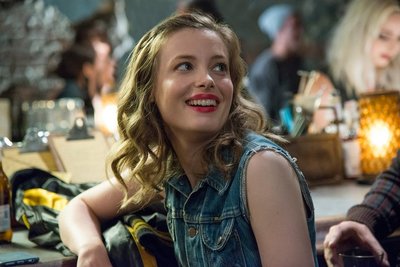
BY KAREN KEMMERLE |
David Lowery on ‘Ain’t Them Bodies Saints’ and Making the Transition from Editing to Directing
We spoke to the Dallas-based filmmaker about blogging, the importance of knowing your cinematic history and why you shouldn’t feel bad hating your movie at first.

After working steadily as an editor in the indie film scene for years, David Lowery is making waves with his second feature, Ain’t Them Bodies Saints. Easily one of the most-talked about films of the 2013 Sundance Film Festival, this lyrical stunner follows the story of two outlaws in love, played by Casey Affleck and Rooney Mara, who are separated by a jail sentence and miles and miles of the American southwest landscape.
Clearly drawing inspiration from great auteurs like Terence Malick and Wim Wenders, Lowery has honed his skills by watching movies and editing indie hits like Upstream Color and Sun Don’t Shine. We spoke to the Lowery about leaving room for happy accidents, why film school isn’t necessary to becoming a filmmaker and working with cinematographer Bradford Young.
Tribeca: I spent an hour or so yesterday reading through all the Ain’t Them Bodies Saints Frames series on your blog and was fascinated. What was the impetus for keeping this kind of diary after the fact?
DL: That blog existed before blogs were called blogs. I first started writing in 1999 right after I graduated high school. I just wanted to discuss my process of trying to become a filmmaker, and it was a great way to just sort of talk about it. The blog evolved over the years, but it has definitely been a part of my identity for a long time.
I was known as the guy who has this blog that would write about movies that I saw and do film criticism and write about all sorts of things. However, in the year spent making the Ain’t Them Bodies Saints, I didn’t really keep up with it at all. I didn’t have time to do it, and I was focused on other things. But in the past few months, I just thought it’d be a good time to jump back in and just talk about things. There’s no denying that I’ve been very open about everything I’ve done in the past and I wanted to be able to do that with this film too, because there’s no reason not to.
It’d be easy to pretend that I’m someone like Thomas Pynchon who hides from public view and disappears or Stanley Kubrick—and there’s something admirable about that—but it’s never been a part of who I am. So I figured I’m just going to embrace it and start talking about the movie again.
Tribeca: From James Grey’s Two Lovers to Hitchcock’s Marnie to, of course, Terence Malick films, your blog and your ATSB Frames selection series are full of film references and cinematic moments that inspired you. How vital is it for aspiring filmmakers to have a working knowledge of cinema history? Can this be taught in film school?
DL: I think it helps a great deal. I didn’t go to film school so I was really behind the curve and still am in terms of cinema history and knowing a lot about it. I still have not even started to scratch the surface of the works of any great filmmakers. I think you could make a great film without having seen that many movies, if you are an instinctive artist who just understands what you are doing.
I understand the value of working in a bubble and just seeing what happens, but as someone who loves movies, I think it’s important to have a breadth of knowledge. It’s not only fun to watch all these movies to learn and see how the medium has changed or stayed the same over the course of history, but also fun to see what other people have done and the methods other people have used.
If I were to have just seen Pulp Fiction without knowing that no one had done anything like that before, that’d be fine. However, I saw Pulp Fiction when I was 13. I was like, ‘this is a movie that’s never been done before.’ It changed my world and led me to discover Jean Luc-Godard and the French New Wave.
It’s so satisfying to trace that lineage back and see how one filmmaker has learned from another, and that helps inform how you can learn from them. It helps you to identify your own voice. It’s really important for a filmmaker to have their own perspective and not just be regurgitating what someone else has done. I think that the way you do that is just to take in as much as you can process, set it aside, and understand where you’re coming from and how your point of view is distinctly yours.
 Tribeca: Since you didn’t go to film school yourself, do you think just watching movies and making them is your best sort of school?
Tribeca: Since you didn’t go to film school yourself, do you think just watching movies and making them is your best sort of school?
DL: I think it just depends on the personality. I was someone who always hated school. I never wanted to go to class, so it made sense for me not to go. You can certainly learn everything on your own time. You can work on movie sets as a P.A., you can buy a fully professional camera for a very little amount of money, and you can edit your own movies. All that stuff is at your disposal at this point. Plus, you have most of film history online. You can click and get an instant education. It depends on whether you need the context of an education to learn all that.
If I had gone to film school right after high school, I certainly would have gotten it a lot faster. I didn’t start really delving into movies until a few years afterwards when I realized I needed to catch up on stuff. It depends on the person.
Tribeca: Before St. Nick and Ain’t Them Bodies Saints, you were (and still are) an editor, working on films like Sun Don’t Shine and Upstream Color. How did you make that transition to directing? Was it just a natural progression?
DL: I really always set out to be a director. I decided that’s what I wanted to do and that’s all I’ve ever wanted to pursue from when I was seven years old. Editing was a means to an end in that I needed to edit my own movies because no one else was going to do it. It was just something I taught myself how to do and I got—to some extent—good enough at it that people started asking me to edit their movies and their short films.
These were just friends at that point, but that eventually editing became a way to make a living because I could edit commercials or corporate videos to make money while I really honed my skills as a filmmaker. To me, with the type of movies I want to make, the editing is where the movie really comes together. That’s the most important step, and that’s the step that I love the most. I learned a great deal by working on other projects. I was directing all through that time, though. I made a lot of bad movies that no one will ever see, short films that are thankfully hidden. [laughs]
Eventually, people started programming them at festivals and my work gained a bit of modest notoriety. When made my first feature, St. Nick in 2009, I was working on other people’s movies the whole time. I worked on Joe Swanberg’s movies as his only other crewmember. I just wanted to help my friends make their movies and participate in work that I thought was valuable both culturally and in terms of the art of cinema.
After St. Nick and my short, Pioneer, I kept editing until Ain’t Them Bodies Saints came about. It was originally going to be a very small movie. I was going to make it for as little as I could, as quickly as I could, very guerilla style, which is how I’ve always made everything. It just got a little more momentum than anything else I’ve done before. [laughs]
You can never look for happy accidents but you need to be aware of them when they happen and to know if there’s an opportunity to chase one down.
Tribeca: I noticed that you were not the main editor on Ain’t Them Bodies Saints. Why did you choose to hand over the reins to Craig McKay (an Oscar nominee) and Jane Rizzo?
DL: It was partially practical and partially out of curiosity. Working as an editor, I always valued what I could bring to the table for a director. If the relationship and chemistry was right, I felt that I could always help them make their movie better than they would have been able to do otherwise. I wanted to have that experience. I wanted to walk out of room and come back and have someone show me a scene that was cut together way better than I would’ve done it myself.
Plus, this movie was a union production, so we had to have a union editor. I could have joined the union, but I wanted to get someone else and see what happened. Jane did all the first half of the movie. We went through a few cuts with her and it was a fantastic experience, but ultimately I also needed to go off and spend some time with the movie on my own.
So I did that, and then one of my producers that worked with Craig on a different film, Sin Nombre, recommended that I let him take a crack at it, just to see another perspective. He did have a different mindset about how to edit, but ultimately I jumped in again because rather than tell someone what to do or what I wanted, it was easier to just do it myself.
Because we were still working together, my starting to edit created some degree of friction and it wasn’t going as smoothly as I wanted. If you’re on your own, you can just walk away and go for a jog or go do something else. You just deal with it for as long as you can on a given day and then you come back fresh. When you are working with other people, you don’t have that luxury.
So now, moving forward I know that next time I shoot a movie, I will take a week off, and then spend some time just messing with the editing on my own first. When I bring someone in, it will be a much more positive work environment because I already know what it is we’re working with. When you first see that raw footage for the first time, see that first assembly, it’s always going to be a shock to the system.
Tribeca: You were quoted as saying, “editing is alchemy,” which I thought was really striking. How would you describe your directing process?
DL: My directing process is a weird mixture of fumbling around in the dark and knowing exactly what I want. A lot of the time, I will go into a scene and have a very clear vision of how I want it to look, how I want it to feel, where I want it to begin and end, and the shots that we’ll use to bring everything about. But other times, and even on the occasions when I know exactly what I want, I’m always trying to look for things that I didn’t anticipate. You can never look for happy accidents but you need to be aware of them when they happen and to know if there’s an opportunity to chase one down.
I try to leave enough room in the scripts for things that I couldn’t predict would happen, and for directions that were new to me or feelings that I hadn’t anticipated being part of the shoot. When I say fumbling around in the dark, it’s because of those things that I can’t quite explain from the get-go. Sometimes it’s a very loose idea or a feeling or an image that I can’t nail down or a polarity between two characters that is too elusive to describe. So you’re trying to find these intangible things within the parameters of a very constructed environment.
You have your shot list, you know what your shots are going to look like, but you’re also trying to capture something almost indescribable and almost abstract. And I love when you can nail the elusive image or thought because it’s like lightning in a bottle. It doesn’t happen that often.
 Tribeca: Bradford Young is one of the fastest rising stars in the field of cinematography. Every frame in Ain’t Them Bodies Saints is practically a work of art. How did you decide to collaborate? Also, please speak to the decision to shoot on Kodak 35?
Tribeca: Bradford Young is one of the fastest rising stars in the field of cinematography. Every frame in Ain’t Them Bodies Saints is practically a work of art. How did you decide to collaborate? Also, please speak to the decision to shoot on Kodak 35?
DL: The decision to shoot 35 was just natural because we wanted the movie to feel old-fashioned. I love digital. It’s kind of a comfort zone for me because I can use all of the equipment and I know how it all works, but it would have added a touch of modernity to the movie that I didn’t want or that I felt it didn’t need. Bradford was someone I didn’t know personally before making this movie. I was aware of his work, but I didn’t really know him as a cinematographer. I had just seen his movies and I liked the way they looked.
My producer set up a meeting for us after they made Mother of George together. I had interviewed a lot of DPs who I really liked but hadn’t found anyone who I’d really just synched with yet. I knew Brad’s work was exquisite, and I knew that he hadn’t done anything like what this movie would look like, but I felt like the potential was there.
So we sat down for breakfast and it was just like perfect synchronicity from day one. You want that from your collaborators. You want someone who is finishing your sentences; you want someone who you feel you’ve grown up with. Brad was instantly that for me, so it was kind of a no-brainer.
We wanted the movie to feel like it was in a different era. We tried to keep the camera locked down a lot of the time, to use a lot of slow moves, and to respect the fact that the camera is a heavy thing. Rather than let the framing be effusive or deliberately obscure, we put everything in the middle. We tried to always have these strong medium shots that were kind of iconic in their framing and composition. We did all these things with the negative, you know, trying to make it look as antique as possible as well, but it really came down to just wanting to make a movie that consisted of strong images.
It’s so satisfying to trace that lineage back and see how one filmmaker has learned from another, and that helps inform how you can learn from them.
Tribeca: Being accessible to fans and film enthusiasts is something that is becoming more and more essential for filmmakers if they want to get their projects out to their audiences. What do you get out of social media and blogging? How important is it to be an active voice in the indie film community?
DL: There’s no denying that it helps as long as you have something to say. I always try to make anything that I write or put out into the world be of value, so that people will engage with me. I want to provoke engagement.
Working with other filmmakers has been wonderful. I think it is valuable for me to understand who my peers are and what they are doing. Fellow filmmakers can provide a bedrock of support. It has certainly been an immense help to have all these folks to back me up when I need it, or to give me a safety net when I need that.
Participating in the world is a huge part of it. Whether it’s on Twitter or online or going to someone else’s movie and talking to them afterwards, or going to a film festival and meeting new people. I can’t state enough how important it is to be part of the film community.
Ain't Them Bodies Saints opens this Friday, August 16, at Film Society of Lincoln Center and the IFC Center.

